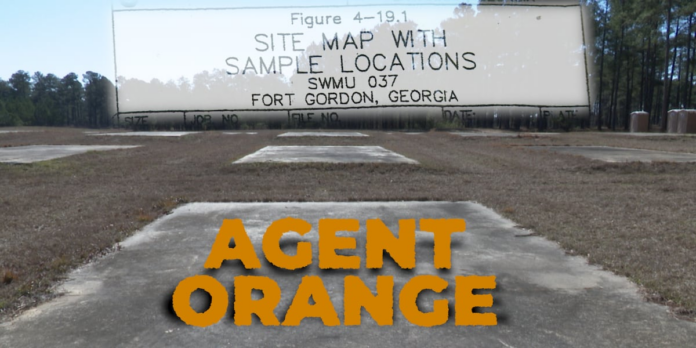AUGUSTA, Ga. (WRDW/WAGT) – The Veterans Administration is considering a change that could make it easier for veterans exposed to Agent Orange to get benefits , and this hits close to home.
News 12 uncovered maps showing Agent Orange was sprayed at Fort Eisenhower.
It happened on a remote part of then-Camp Gordon known as Camp Crockett. Camp Gordon became Fort Gordon, and Fort Gordon was renamed Fort Eisenhower in October of 2023.
Now, the VA is looking to put Fort Eisenhower on the list of locations where veterans stationed there during a certain timeframe who are diagnosed with certain cancers or chronic illnesses would not have to prove they were exposed to Agent Orange. That exposure would already be presumed.
For the first time, our cameras can show you exactly where Agent Orange was sprayed.
Fort Eisenhower is about 56,000 acres, but the area that was once Camp Crockett was only a small fraction of it; it’s only about 40 to 50 acres located smack dab in the middle of the installation.
You could call Camp Crocket a blip on Fort Eisenhower’s radar.
Soldiers started training for Vietnam there in 1967, but the Army abandoned it a short time later in 1969.
The mock Vietnamese villages might have been temporary, but what happened at Camp Crockett left a permanent mark on hundreds – maybe even thousands – of veterans and their families.
“We didn’t know what we were working with,” said James Cripps.
EARLIER COVERAGE:
He is one of those veterans affected every day by Agent Orange exposure.
“Agent Orange, back then, didn’t even have the name, Agent Orange,” said Cripps.
For years, the United States Government denied Agent Orange was ever tested there until Cripps became the first person to ever prove he was exposed to it – not in the jungles of Vietnam, but at Camp Crockett on what is now Fort Eisenhower.
“My military service was easy. The fight with a VA lasted five times as long and was 10 times as hard,” said Cripps.
His winning claim and the map News 12 uncovered more than a decade ago exposing Agents Blue, Orange, and White were tested in our own backyard continue to help other veterans win their claims of exposure.
Joseph Webb sent this email: “Your news stories and my research helped me get 100% VA compensation.”
Court cases online also show veterans submitting our I-TEAM investigations as evidence supporting their claims.
Today, Camp Crockett is now a field with some concrete slabs where Quonset huts used to be.
Autoplay
We’re told the land pretty much sat empty after 1969, and it was overgrown by the time the Army cleared it in 1997 to use it for medical training.
Regional Medical Training (RTS-Med) happened here using those concrete slabs as a base for tents.
Mobile cyber units train here, too.
We’re told it looks nothing like it would have looked in the late 1960s.
“It was an overflow camp. They didn’t have running water, and I can remember, especially on the weekends, they didn’t have showers, so they would have to walk down to Leitner Lake, which sits right below Camp Crockett,” said Cripps.
Leitner Lake is still there today. It’s a campground and recreation area.
“Little did they know, right upstream, I was up there spraying Agent Orange into those lakes,” said Cripps.
Cripps says he’s worried about soldiers who had no idea they were exposed to the dangerous toxin. He says he worries about the health of Fort Eisenhower in general.
“So, how are we going to say it’s no longer in the soil at Fort Gordon, but we’re spending millions of dollars in Vietnam cleaning up over there? It doesn’t make sense,” said Cripps.
The Army tests drinking water on Fort Eisenhower two times a year.
According to Environmental Command, the last test was in June of 2023, but experts are testing for PFOS and PFOA, or forever chemicals. The latest test results show they were “below the lab’s ability to detect.” The next test is scheduled for this month.
As for the VA and possible plans to expand its list of presumptive locations, the public comment period closed this week.
We will track this and keep you posted on its progress.
Cripps recently discovered a document submitted with his claim could prove Agent Orange was stored at Fort Eisenhower until the mid-1980s. He believes it helped him win his claim.
If you think that document could help you or someone you know with a claim, here is a copy:
Here are the documents News 12 obtained from our Freedom of Information Act request:
Copyright 2024 WRDW/WAGT. All rights reserved.
I-TEAM UPDATE: What does the Agent Orange testing site at Fort Eisenhower look like today?
RELATED ARTICLES



